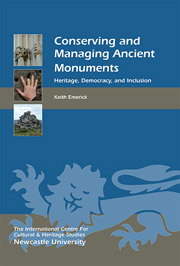Book contents
- Frontmatter
- Contents
- List of Illustrations
- Acknowledgments
- List of Abbreviations
- Introduction
- 1 The Restoration of Hellifield Peel and the Heritage Debate
- 2 The Origins of the Conservation of Ancient Monuments and the Beginnings of State Control in the United Kingdom
- 3 Practice Perfected: the Ancient Monuments Act of 1913 and the Consolidation of State Preservation Practice
- 4 British Conservation Practice in Cyprus, 1878 to 1939: a Case Study
- 5 Current Directions in England: the Emergence of Cultural Heritage Management and the Use of Conventions, Charters and Principles
- 6 Putting Theory into Practice
- 7 Conclusion: Ending the Tyranny of Ruskin and Morris?
- Appendices
- Bibliography and References
- Index
1 - The Restoration of Hellifield Peel and the Heritage Debate
Published online by Cambridge University Press: 05 August 2014
- Frontmatter
- Contents
- List of Illustrations
- Acknowledgments
- List of Abbreviations
- Introduction
- 1 The Restoration of Hellifield Peel and the Heritage Debate
- 2 The Origins of the Conservation of Ancient Monuments and the Beginnings of State Control in the United Kingdom
- 3 Practice Perfected: the Ancient Monuments Act of 1913 and the Consolidation of State Preservation Practice
- 4 British Conservation Practice in Cyprus, 1878 to 1939: a Case Study
- 5 Current Directions in England: the Emergence of Cultural Heritage Management and the Use of Conventions, Charters and Principles
- 6 Putting Theory into Practice
- 7 Conclusion: Ending the Tyranny of Ruskin and Morris?
- Appendices
- Bibliography and References
- Index
Summary
‘The past is never dead. It's not even past.’
(Faulkner 1960)On 28 February 2007 the British television station Channel 4 broadcast an episode of Grand Designs. Grand Designs is a series of programmes produced by Talkback Thames for Channel 4 and presented by the architectural historian and writer Kevin McCloud. Usually an hour in length, the programme follows members of the public who volunteer their own construction projects to be filmed and presented in a fly-on-the-wall style, charting the vicissitudes of the design and construction process. Most of the projects tend to be ‘new-build’ schemes, although the adaptation of a small number of Listed Buildings (buildings designated as ‘nationally important’) has been covered. The 90-minute episode of Grand Designs aired on 28 February 2007 was the first in a new series but was considered to be something of a ‘special’ because of the unusual nature of the project: the conservation and restoration of a ruined medieval structure to a domestic dwelling. The building is known as Hellifield Peel and is both a Listed Building and a Scheduled Monument (a place considered to be nationally important by virtue of its archaeological value and protected under the provisions of the 1979 Ancient Monuments and Archaeological Areas Act).
Hellifield is a village located immediately outside the south-western boundary of the Yorkshire Dales National Park, in Craven District, North Yorkshire. Situated on the A65 almost midway between the towns of Skipton (eight miles to the south-east) and Settle (five miles to the north-west), Hellifield has a population of about 1100. The early industry of Hellifield was largely restricted to hand cotton-weaving and agriculture, but in the 19th century the advent of the railways had a massive impact on the village, turning a small hamlet into a major passenger and freight interchange on the Lancashire and Yorkshire and Settle to Carlisle railway lines. This transport significance was also translated into buildings, with many new streets and houses constructed by the railway companies for railway employees. Following the cuts to and closures of railway services, stations and connections in the 1960s, Hellifield suffered from the inevitable economic downturn, but still retains a strong agricultural and livestock base and is now reinventing itself as one of several ‘gateways’ into the Yorkshire Dales.
- Type
- Chapter
- Information
- Conserving and Managing Ancient MonumentsHeritage, Democracy, and Inclusion, pp. 13 - 28Publisher: Boydell & BrewerPrint publication year: 2014



